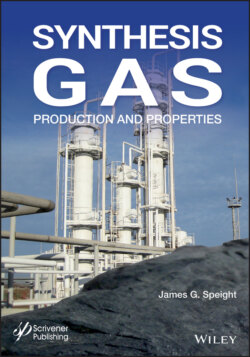Читать книгу Synthesis Gas - James Speight G., James G. Speight - Страница 54
2.5.5.6 Methanation
ОглавлениеSeveral exothermic reactions may occur simultaneously within a methanation unit. A variety of metals have been used as catalysts for the methanation reaction; the most common, and to some extent the most effective methanation catalysts, appear to be nickel and ruthenium, with nickel being the most widely used (Cusumano et al., 1978):
Nearly all the commercially available catalysts used for this process are, however, very susceptible to sulfur poisoning and efforts must be taken to remove all hydrogen sulfide (H2S) before the catalytic reaction starts. It is necessary to reduce the sulfur concentration in the feed gas to less than 0.5 ppm v/v in order to maintain adequate catalyst activity for a long period of time.
The synthesis gas must be desulfurized before the methanation step since sulfur compounds will rapidly deactivate (poison) the catalysts. A processing issue may arise when the concentration of carbon monoxide is excessive in the stream to be methanated since large amounts of heat must be removed from the system to prevent high temperatures and deactivation of the catalyst by sintering as well as the deposition of carbon. To eliminate this problem, temperatures should be maintained below 400oC (750oF).
The methanation reaction is used to increase the methane content of the product gas, as needed for the production of high-Btu gas.
Among these, the most dominant chemical reaction leading to methane is the first one. Therefore, if methanation is carried out over a catalyst with a synthesis gas mixture of hydrogen and carbon monoxide, the desired hydrogen-carbon monoxide ratio of the feed synthesis gas is around 3:1. The large amount of water (vapor) produced is removed by condensation and recirculated as process water or steam. During this process, most of the exothermic heat due to the methanation reaction is also recovered through a variety of energy integration processes.
Whereas all the reactions listed above are quite strongly exothermic except the forward water gas shift reaction, which is mildly exothermic, the heat release depends largely on the amount of carbon monoxide present in the feed synthesis gas. For each 1% v/v carbon monoxide in the feed synthesis gas, an adiabatic reaction will experience a 60°C (108oF) temperature rise, which may be termed as adiabatic temperature rise.
